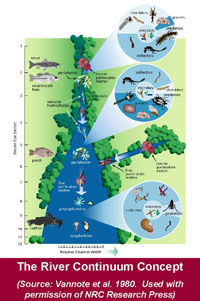The River Continuum Concept
The River Continuum Concept is an attempt to generalize and explain longitudinal changes in stream ecosystems (Vannote et al. 1980). This conceptual model not only helps to identify connections between the watershed, floodplain, and stream systems, but it also describes how biological communities develop and change from the headwaters to the mouth. The River Continuum Concept can place a site or reach in context within a larger watershed or landscape and thus help practitioners define and focus restoration goals.
The River Continuum Concept hypothesizes that many first- to third-order headwater streams are shaded by the riparian forest canopy. This shading, in turn, limits the growth of algae, periphyton, and other aquatic plants. Since energy cannot be created through photosynthesis (autotrophic production), the aquatic biota in these small streams is dependent on allochthonous materials (i.e., materials coming from outside the channel such as leaves and twigs).
Biological communities are uniquely adapted to use externally derived organic inputs. Consequently, these headwater streams are considered heterotrophic (i.e., dependent on the energy produced in the surrounding watershed). Temperature regimes are also relatively stable due to the influence of ground water recharge, which tends to reduce biological diversity to those species with relatively narrow thermal niches.
Predictable changes occur as one proceeds downstream to fourth-, fifth-, and sixth-order streams. The channel widens, which increases the amount of incident sunlight and average temperatures. Levels of primary production increase in response to increases in light, which shifts many streams to a dependence on autochthonous materials (i.e., materials coming from inside the channel), or internal autotrophic production (Minshall 1978).
In addition, smaller, preprocessed organic particles are received from upstream sections, which serves to balance autotrophy and heterotrophy within the stream. Species richness of the invertebrate community increases as a variety of new habitat and food resources appear. Invertebrate functional groups, such as the grazers and collectors, increase in abundance as they adapt to using both autochthonous and allochthonous food resources. Midsized streams also decrease in thermal stability as temperature fluctuations increase, which further tends to increase biotic diversity by increasing the number of thermal niches.
Larger streams and rivers of seventh to twelfth order tend to increase in physical stability, but undergo significant changes in structure and biological function. Larger streams develop increased reliance on primary productivity by phytoplankton, but continue to receive heavy inputs of dissolved and ultra-fine organic particles from upstream. Invertebrate populations are dominated by fine-particle collectors, including zooplankton. Large streams frequently carry increased loads of clays and fine silts, which increase turbidity, decrease light penetration, and thus increase the significance of heterotrophic processes.
The influence of storm events and thermal fluctuations decrease in frequency and magnitude, which increases the overall physical stability of the stream. This stability increases the strength of biological interactions, such as competition and predation, which tends to eliminate less competitive taxa and thereby reduce species richness.
The fact that the River Continuum Concept applies only to perennial streams is a limitation. Another limitation is that disturbances and their impacts on the river continuum are not addressed by the model. Disturbances can disrupt the connections between the watershed and its streams and the river continuum as well.
The River Continuum Concept has not received universal acceptance due to these and other reasons (Statzner and Higler 1985, Junk et al. 1989). Nevertheless, it has served as a useful conceptual model and stimulated much research since it was first introduced in 1980.
![[logo] US EPA](https://www.epa.gov/epafiles/images/logo_epaseal.gif)
